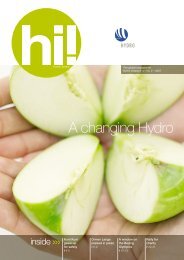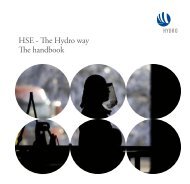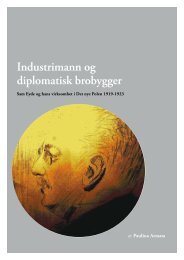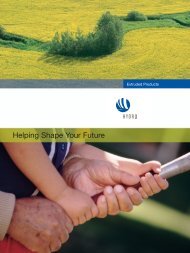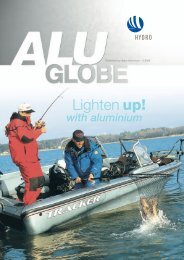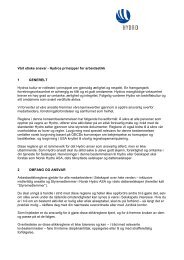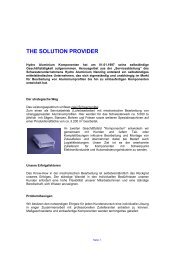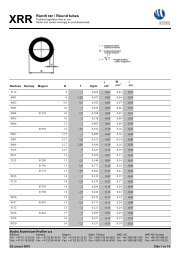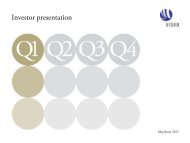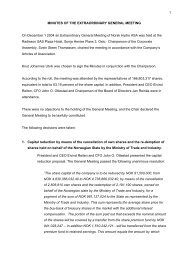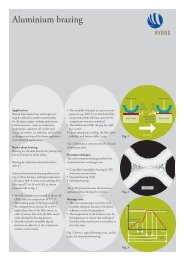Hydro Annual Report 2011b
Hydro Annual Report 2011b
Hydro Annual Report 2011b
Create successful ePaper yourself
Turn your PDF publications into a flip-book with our unique Google optimized e-Paper software.
Water management<br />
Enough clean water is a challenge in some of the areas where<br />
<strong>Hydro</strong> operates. Local initiatives show that with simple measures,<br />
substantial water savings are achievable. The systematic<br />
mapping of our water situation in 2011 showed that about 3<br />
percent of our overall water input came from water-stressed<br />
areas, with regard to annual renewable water supply (according<br />
to the definition used by WBCSD).<br />
Although the Amazon is recognized for its abundance of water,<br />
we have observed over the last decades that parts of the area<br />
have had repeated droughts. We will therefore carefully address<br />
water as an issue also for our sites in Brazil. Qatalum gets water<br />
from public water works, produced by desalination. Sea water<br />
is used for wet cooling towers at the power plant.<br />
We regularly follow up the impact on aquatic life in rivers near<br />
our hydropower plants. In addition, we are following up a<br />
rehabilitation project of the Måna River in Rjukan, Norway.<br />
In 2011, this included improvement of fish habitats. We will<br />
in 2012 start similar projects in the Årdal river and fortun<br />
river. All projects also include increased accessibility to the riversides<br />
for the local communities.<br />
According to requirements in our hydropower concessions, we<br />
finance operation of two fish nurseries in Sogn in Norway.<br />
Trout are bred every year, and approximately 100,000 fish fries<br />
are stocked in the small lakes in the concession area. This mitigates<br />
the impacts from the regulation of the water going to the<br />
power plants. In the fortun River we also stock salmon fries<br />
every year in order to maintain the population.<br />
Minimizing waste<br />
Our goal is to minimize the amount of waste produced and<br />
then reuse or recycle it. This is beneficial, both environmentally<br />
and economically.<br />
Tailings and bauxite residue<br />
Tailings from bauxite extraction consist of mineral rejects from<br />
the extraction process mixed with water. No chemicals are<br />
added. The tailings at Paragominas are stored in dedicated tailing<br />
ponds, where the particles settle. Separated water is transferred<br />
to a clarification dam before it is reused in the process.<br />
There is a minor run-off to the river downstream of the tailings,<br />
which is required to maintain an ecological flow. The<br />
run-off is monitored, and the water quality meets the requirements<br />
set by the authorities.<br />
The current tailing ponds are reckoned to be full by 2015-<br />
2020. The area will then be reforested. The total production of<br />
tailings in 2011 was 5.9 million metric tons (mt). The Paragominas’<br />
mine produced 8.2 million mt bauxite in 2011.<br />
Bauxite residue, also known as red mud, is a by-product of the<br />
alumina refining process. Alunorte uses the Bayer process,<br />
vIABIlItY perForMAnCe<br />
Resource management<br />
55<br />
which includes the use of caustic soda. The residue is washed<br />
with water to lower the alkalinity and recover caustic soda to<br />
be reused in the process. The residue is dry-stacked, which<br />
means it is transformed into a clay-like solid with a low moisture<br />
content. Alunorte is in the process of reducing the moisture<br />
further through conversion to pressure filtration.<br />
The bauxite residue deposit at Alunorte was extended in 2011.<br />
In total, 6.4 million mt were disposed in 2011. When the<br />
deposits are full, we have a plan for replanting of the area.<br />
Bauxite residue from Alunorte is being tested as a raw material<br />
for bricks and paving stones, but even with an optimistic market<br />
estimate, this production will only use a small fraction of<br />
the total residue. The remaining residue is disposed and<br />
replanted.<br />
After a spillage in 2009 of storm water from the bauxite residue<br />
deposits at Alunorte, corrective actions have been taken,<br />
including strengthening the drainage system and improving<br />
the surveillance of the water treatment facility. A need for better<br />
emergency handling, including information to the local<br />
community, was also identified. There are still legal issues<br />
pending following the incident, such as individual lawsuits<br />
filed by local residents who claim compensation for damages<br />
caused by the spillage. So far all of the claims have been dismissed.<br />
There is also a negotiation in place with the public<br />
prosecutor, who claims compensation for the environmental<br />
damages caused by the spillage. If an agreement is not reached<br />
with the public prosecutor, a class action lawsuit can be filed<br />
against Alunorte in this regard.<br />
Other waste<br />
Spent potlining (SPL) from the reduction cells used in primary<br />
aluminium production is defined as hazardous waste. In<br />
2011, we generated 24,804 metric tons of SPL, which was 29<br />
percent below the amount from 2010. The production of SPL<br />
varies with the relining of smelter cells which is normally done<br />
every 4-7 years for established smelters. New plants will get a<br />
relining peak at the same interval after start-up. We expect an<br />
increase in the SPL production from consolidated smelters in<br />
a couple of years and from part-owned Qatalum some years<br />
later.<br />
Qatalum is aiming at “no-SPL-to-landfill”, together with other<br />
aluminium plants in the Arabian Gulf, with a view to using<br />
SPL in the cement industry.<br />
In 2009, we formalized a cooperation with an external partner<br />
to help identify applications for production waste from our<br />
aluminium plants in Norway. The planned recycling plant at<br />
Karmøy, Norway will also be able to handle dross. The building<br />
of this plant was postponed in 2011, however, due to the<br />
market situation. See also page 59.



